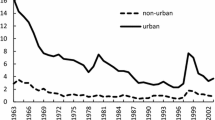Abstract
In the constructed-capital model, the steady state is derived under the assumption that each individual behaves optimally. Contrasting to this decentralized approach, in this paper we derive the first-best outcome a central planner would choose. The results show that agglomeration is socially not optimal, irrespective of the level of trade barriers. Furthermore, the differences in the explicit solutions of both approaches are highlighted.

Similar content being viewed by others
Notes
Therefore capital is a production factor for the manufacturing sector as it determines the number of different machines (equivalent to the number of different products). The number of product varieties depends on the capital stock. However, the amount of each product variety does not depend on the capital.
Trade costs are assumed to be equal for both regions. However, the model allows to generalize this assumption straightforwardly.
A stable population is characterized by constant mortality and fertility rates over time. This implies that the demographic structure does not change.
Note that this implies that the social planner treats each individual in the same way. Therefore a region with a higher population has a higher weight in the social welfare function.
Due to concavity of the Hamiltonian with respect to the states also second-order conditions are fulfilled. As long as the states are positive that concavity is strict.
The time points when a state touches, enters or exits the constraint.
\(\tau ^{+}\) and \(\tau ^{-}\) denote the limit from the right and the left respectively.
A complete list of all possible parameter ranges is provided in Appendix A in Wrzaczek (2010).
For each parameter we have chosen very small steps within the possible parameter interval.
Note that the difference in labor efficiency is due to differences in the demographic structure of the population. The productivity of individuals depends e.g. on age and on their health. However, the demographic structure is not modeled explicitely in our model and assumed as exogenous.
Note that \(\dot{\lambda }^{H} =0\) if \(\dot{K}^{H} =0\), which is fulfilled.
\(L^{H}=L^{F}=1,\,N^{H}=N^{F}=1,\,\rho =0.015,\,\delta =0.05,\,\xi =0.3,\,\sigma =2,\,\varGamma =2,\,\alpha =1,\,\beta =1,\,\varphi =2\)
For clarification once again: \(\hat{K}^{d}\) denotes the equilibrium capital of the decentralized Baldwin model in the symmetric equilibrium, \(\hat{K}^{H}\) and \(\hat{K}^{F}\) denote the equilibrium capital of the centralized model of the home and the foreign country respectively.
References
Baldwin RE (1999) Agglomeration and endogenous capital. Eur Econ Rev 43:253–280
Baldwin RE, Forslid R, Martin P, Ottaviano G, Robert-Nicoud F (2003) Economic geography & public policy. Princeton University Press, Princeton
Barro RJ, Sala-i-Martin X (1998) Economic growth. MIT Press, Cambridge
Brakman S, Garretsen H, van Marrewijk C (2008) Agglomeration and government spending. In: Brakman S, Garretsen H (eds) Foreign direct investment and the multinational enterprise. MIT Press, Cambridge, pp 89–116
Brülhart M, Trionfetti F (2004) Public expenditure, specialisation and agglomeration. Eur Econ Rev 48: 851–871
Commendatore P, Kubin I, Petraglia C (2008) Productive public expenditure in a new economic geography model. Int Econ 114:133–160
Grafeneder-Weissteiner T, Prettner K (2008) Agglomeration and population aging in a two region model of exogenous growth. WU Vienna University of Economics and Business, Department of Economics Working Papers
Feichtinger F, Hartl R (1986) Optimale Kontrolle ökonomischer Prozesse. Anwendungen des Maximumprinzips in den Wirtschaftswissenschaften. Walter de Gruyter, Berlin
Krugman P (1991) Increasing returns and economic geography. J Polit Econ 99:483–499
Krugman P, Venables AJ (1995) Globalization and the inequality of nations. Q J Econ 110:857–880
Marshall A (1920) Principles of economics. MacMillan, London
Martin P, Ottaviano G (1999) Growing locations: industry location in a model of endogenous growth. Eur Econ Rev 43:281–302
Martin P, Rogers CA (1995) Industrial location and public infrastructure. J Int Econ 39:335–51
Puga D (1999) The rise and fall of regional inequalities. Eur Econ Rev 43:303–334
Smith A (1776) The wealth of nations. Various reprints, e.g. Penguin Books
Tafenau E (2008) Can welfare be improved by relocating firms? The case of the constructed capital model. Working Paper No. 64–2008, Faculty of Economics and Business Administration, University of Tartu
Trionfetti F (1997) Public expenditure and economic geography. Annales dconomie et de Statistique 47: 101–120
Trionfetti F (2001) Public procurement, market integration, and income inequalities. Rev Int Econ 9(1): 29–41
Venables AJ (1996) Equilibrium locations of vertically linked industries. Int Econ Rev 37:341–359
von Thünen JH (1826) Der isolierte Staat in Beziehung auf Landschaft und Nationalökonomie. F Perthes, Hamburg
Wrzaczek S (2010) Social optimality in the constructed-capital model, mathematical methods in economics, Research Unit ORCOS, Vienna University of Technology, Research, Report 2010–2008
Author information
Authors and Affiliations
Corresponding author
Additional information
This research was financed by the research project “Agglomeration processes in aging societies” funded by the Vienna Science and Technology Fund (WWTF).
I would like to thank Theresa Grafeneder-Weissteiner (University of Vienna), Ingrid Kubin (WU—Vienna University of Economics and Business), Klaus Prettner (University of Göttingen), Alexia Prskawetz (Vienna University of Technology and Wittgenstein Centre (IIASA, VID/ÖAW, WU), VID/ÖAW), Vladimir Veliov (Vienna University of Technology) and an anonymous referee for helpful comments and fruitful discussions.
Rights and permissions
About this article
Cite this article
Wrzaczek, S. Social optimality in the constructed-capital model. Cent Eur J Oper Res 22, 211–232 (2014). https://doi.org/10.1007/s10100-013-0285-8
Published:
Issue Date:
DOI: https://doi.org/10.1007/s10100-013-0285-8




